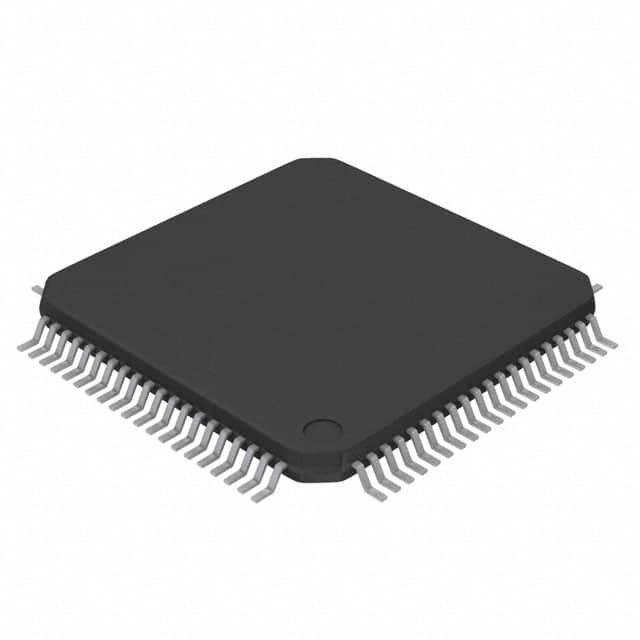Xem thông số kỹ thuật để biết chi tiết sản phẩm.

PIC18C801T-I/PT
Product Overview
Category
The PIC18C801T-I/PT belongs to the category of microcontrollers.
Use
This microcontroller is commonly used in various electronic devices and embedded systems for controlling and managing their operations.
Characteristics
- High-performance 8-bit architecture
- Flash-based program memory
- Wide operating voltage range
- Low power consumption
- Enhanced peripheral integration
- Advanced analog capabilities
Package
The PIC18C801T-I/PT is available in a small form factor package, making it suitable for space-constrained applications.
Essence
The essence of this microcontroller lies in its ability to provide efficient and reliable control and management functions in electronic devices and embedded systems.
Packaging/Quantity
The PIC18C801T-I/PT is typically packaged in tape and reel format, with a quantity of 250 units per reel.
Specifications
- Architecture: 8-bit
- Program Memory Size: 8 KB
- RAM Size: 368 bytes
- Operating Voltage Range: 2.0V to 5.5V
- Maximum Speed: 20 MHz
- Number of I/O Pins: 35
- ADC Channels: 10
- Timers: 3
- Communication Interfaces: UART, SPI, I2C
Detailed Pin Configuration
The PIC18C801T-I/PT microcontroller has a total of 44 pins. The pin configuration is as follows:
- VDD - Power supply voltage
- RA0 - General-purpose I/O pin
- RA1 - General-purpose I/O pin
- RA2 - General-purpose I/O pin
- RA3 - General-purpose I/O pin
- RA4 - General-purpose I/O pin
- RA5 - General-purpose I/O pin
- MCLR - Master Clear input
- VSS - Ground
- RB0 - General-purpose I/O pin
- RB1 - General-purpose I/O pin
- RB2 - General-purpose I/O pin
- RB3 - General-purpose I/O pin
- RB4 - General-purpose I/O pin
- RB5 - General-purpose I/O pin
- RB6 - General-purpose I/O pin
- RB7 - General-purpose I/O pin
- RC0 - General-purpose I/O pin
- RC1 - General-purpose I/O pin
- RC2 - General-purpose I/O pin
- RC3 - General-purpose I/O pin
- RC4 - General-purpose I/O pin
- RC5 - General-purpose I/O pin
- RC6 - General-purpose I/O pin
- RC7 - General-purpose I/O pin
- RD0 - General-purpose I/O pin
- RD1 - General-purpose I/O pin
- RD2 - General-purpose I/O pin
- RD3 - General-purpose I/O pin
- RD4 - General-purpose I/O pin
- RD5 - General-purpose I/O pin
- RD6 - General-purpose I/O pin
- RD7 - General-purpose I/O pin
- RE0 - General-purpose I/O pin
- RE1 - General-purpose I/O pin
- RE2 - General-purpose I/O pin
- VCAP - Capacitor connection for internal voltage regulator
- VDDCORE - Core voltage supply
- VSSCORE - Core ground
- OSC1 - Oscillator input
- OSC2 - Oscillator output
- AVDD - Analog power supply
- AVSS - Analog ground
- NC - No connection
Functional Features
- High-speed processing capabilities
- Flash memory for program storage
- Efficient power management
- Enhanced analog-to-digital conversion
- Multiple communication interfaces for data exchange
- Flexible I/O configuration
- Timers and counters for precise timing operations
- Interrupt handling for real-time event response
Advantages and Disadvantages
Advantages
- High-performance 8-bit architecture enables fast and efficient processing.
- Flash-based program memory allows for easy reprogramming and updates.
- Wide operating voltage range provides flexibility in various applications.
- Low power consumption prolongs battery life in portable devices.
- Enhanced peripheral integration simplifies system design and reduces component count.
- Advanced analog capabilities enable accurate measurement and control.
Disadvantages
- Limited program memory size may restrict the complexity of applications.
- Relatively small RAM size may limit the amount of data that can be processed simultaneously.
- Lack of built-in hardware encryption may pose security concerns in certain applications.
Working Principles
The PIC18C801T-I/PT microcontroller operates based on the Von Neumann architecture. It executes instructions stored in its flash memory, which are
Liệt kê 10 câu hỏi và câu trả lời thường gặp liên quan đến ứng dụng PIC18C801T-I/PT trong giải pháp kỹ thuật
What is the maximum operating frequency of PIC18C801T-I/PT?
- The maximum operating frequency of PIC18C801T-I/PT is 40 MHz.What are the key features of PIC18C801T-I/PT?
- The key features of PIC18C801T-I/PT include 8-bit microcontroller, 16KB program memory, 768 bytes of RAM, and 256 bytes of EEPROM.Can PIC18C801T-I/PT be used for motor control applications?
- Yes, PIC18C801T-I/PT can be used for motor control applications with its integrated PWM modules and analog-to-digital converters.Is PIC18C801T-I/PT suitable for battery-powered devices?
- Yes, PIC18C801T-I/PT is suitable for battery-powered devices due to its low power consumption and sleep modes.What development tools are available for programming PIC18C801T-I/PT?
- Development tools such as MPLAB X IDE and PICkit programmers are available for programming PIC18C801T-I/PT.Can PIC18C801T-I/PT communicate with other devices using serial communication protocols?
- Yes, PIC18C801T-I/PT supports serial communication protocols such as UART, SPI, and I2C.Are there any application notes or reference designs available for PIC18C801T-I/PT?
- Yes, Microchip provides application notes and reference designs for various technical solutions using PIC18C801T-I/PT.What are the temperature range specifications for PIC18C801T-I/PT?
- PIC18C801T-I/PT has a temperature range specification of -40°C to 125°C.Can PIC18C801T-I/PT be used in automotive applications?
- Yes, PIC18C801T-I/PT is suitable for automotive applications with its wide temperature range and robust design.Are there any known limitations or common issues when using PIC18C801T-I/PT in technical solutions?
- Some common issues when using PIC18C801T-I/PT include managing power consumption, optimizing code for limited memory, and ensuring proper EMI/EMC compliance in high-noise environments.

